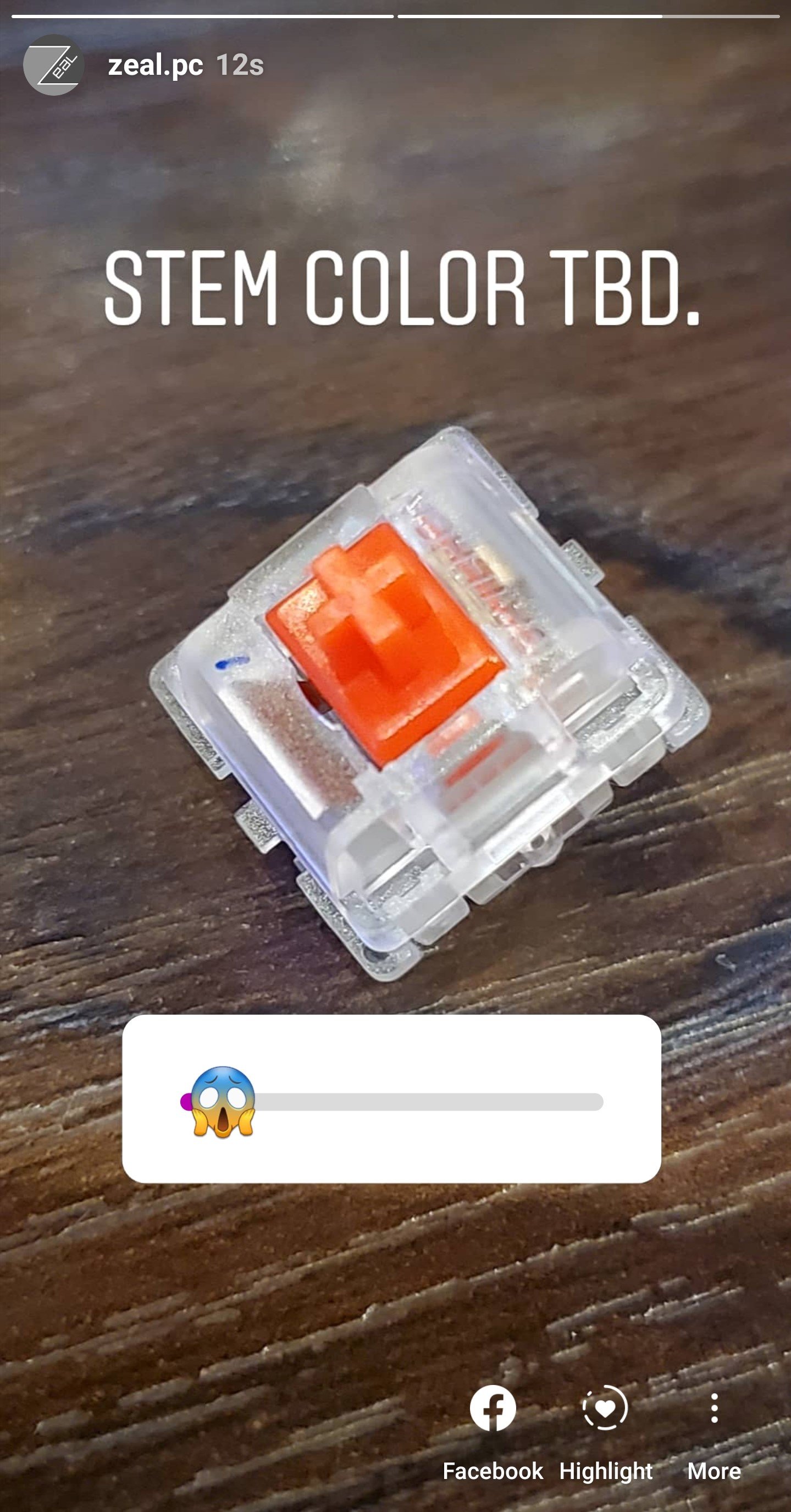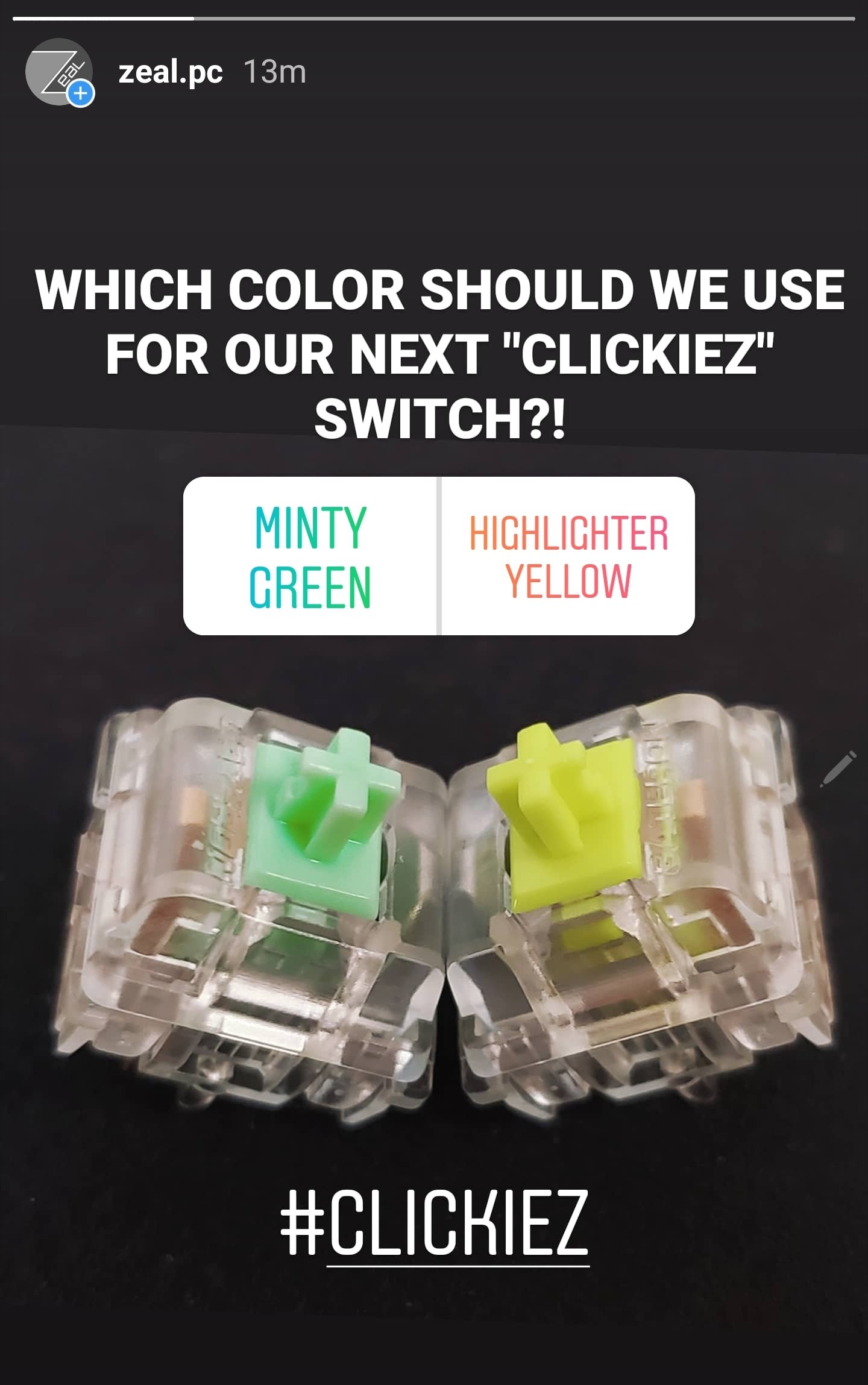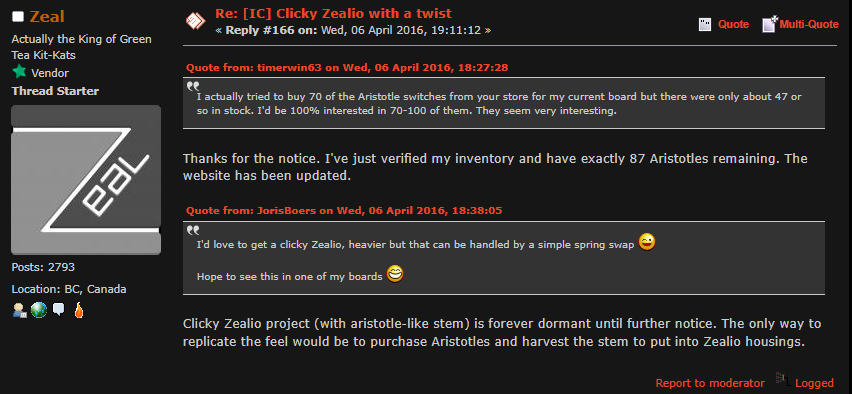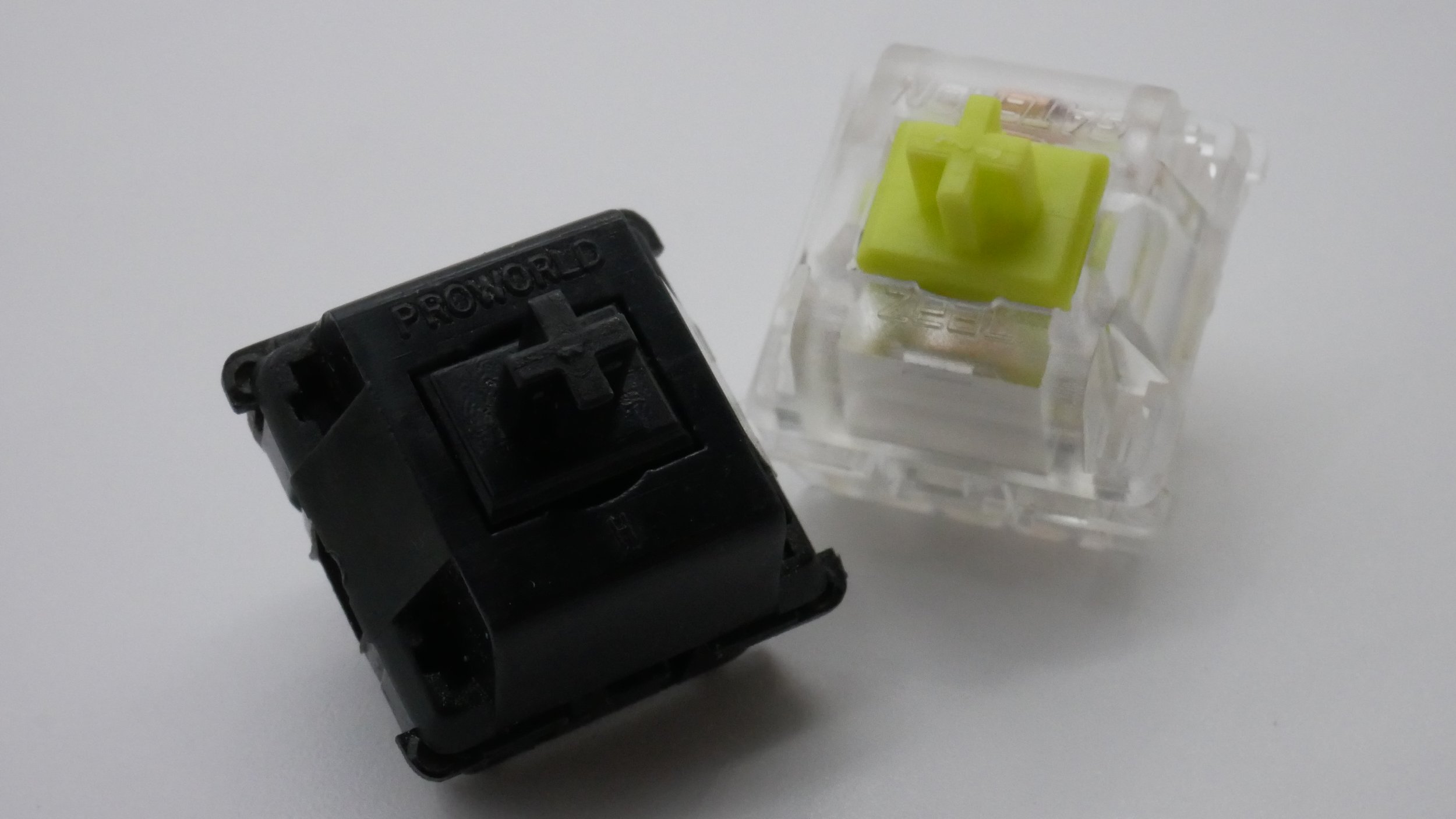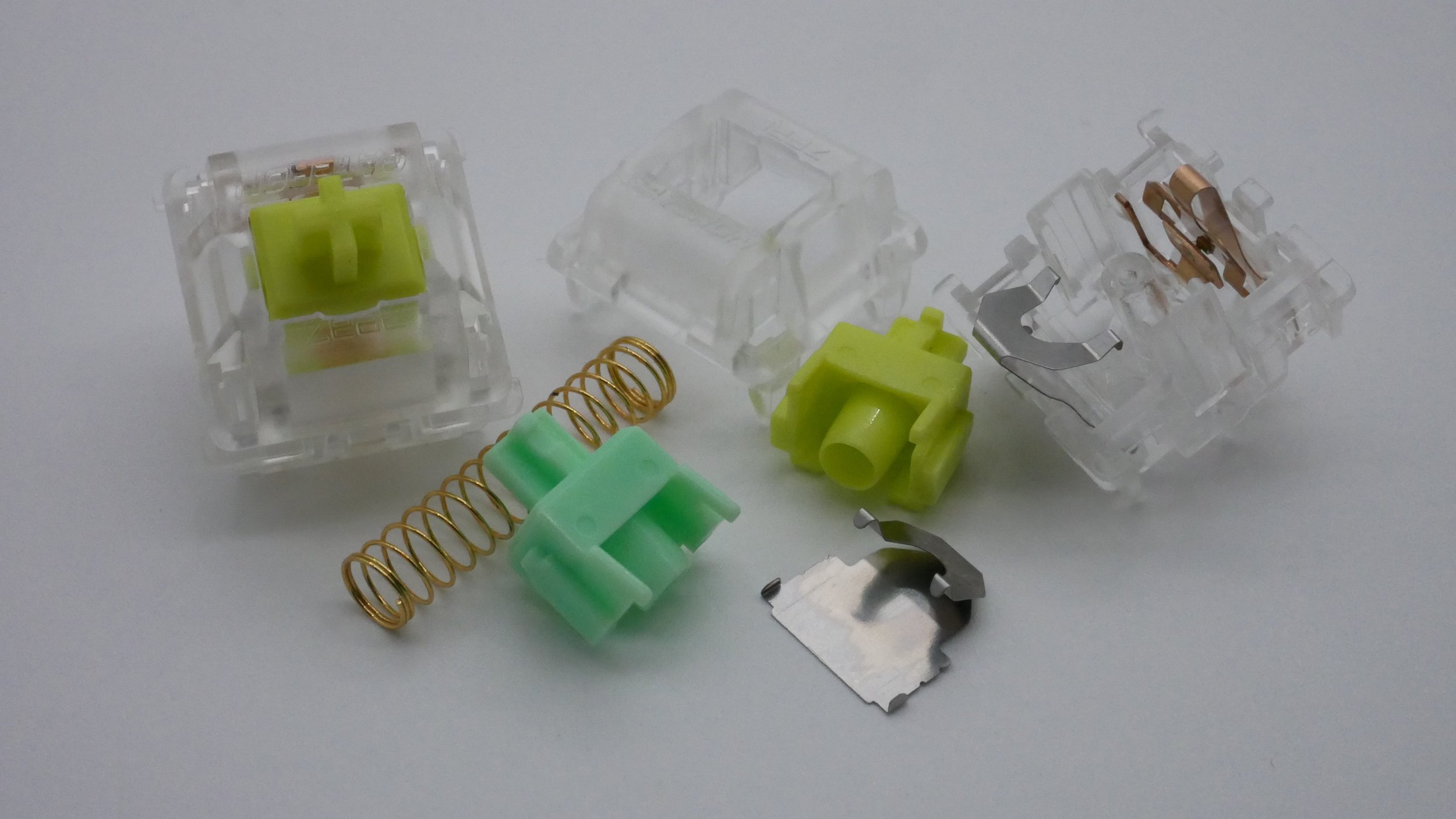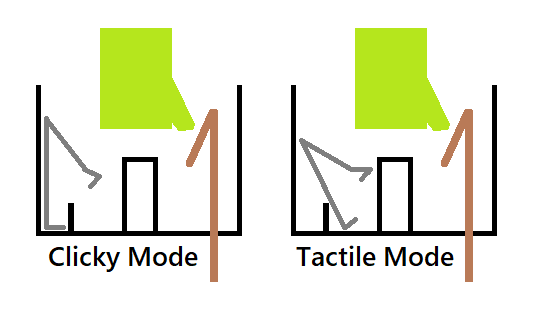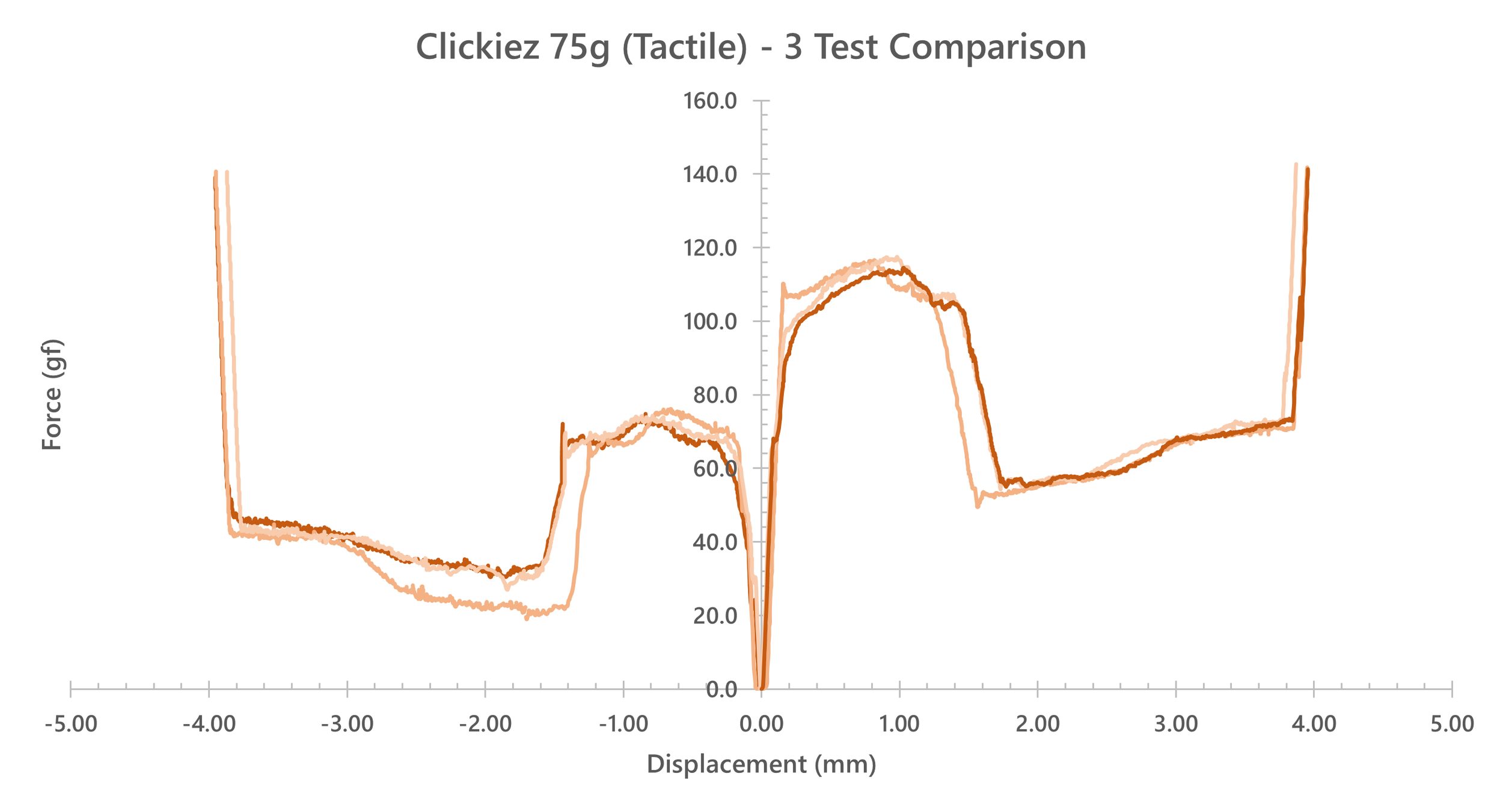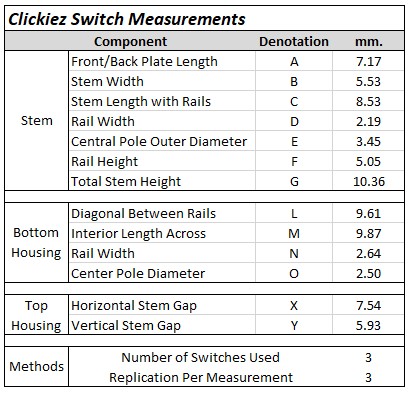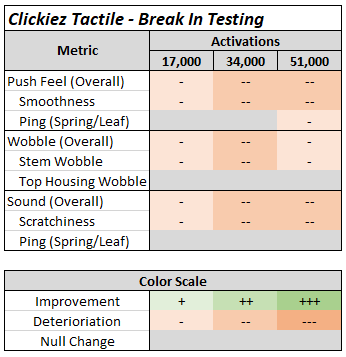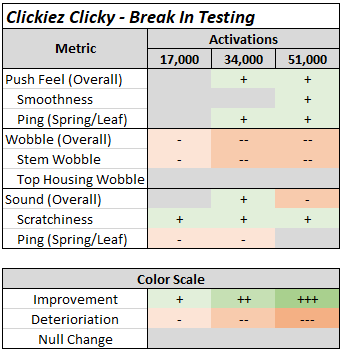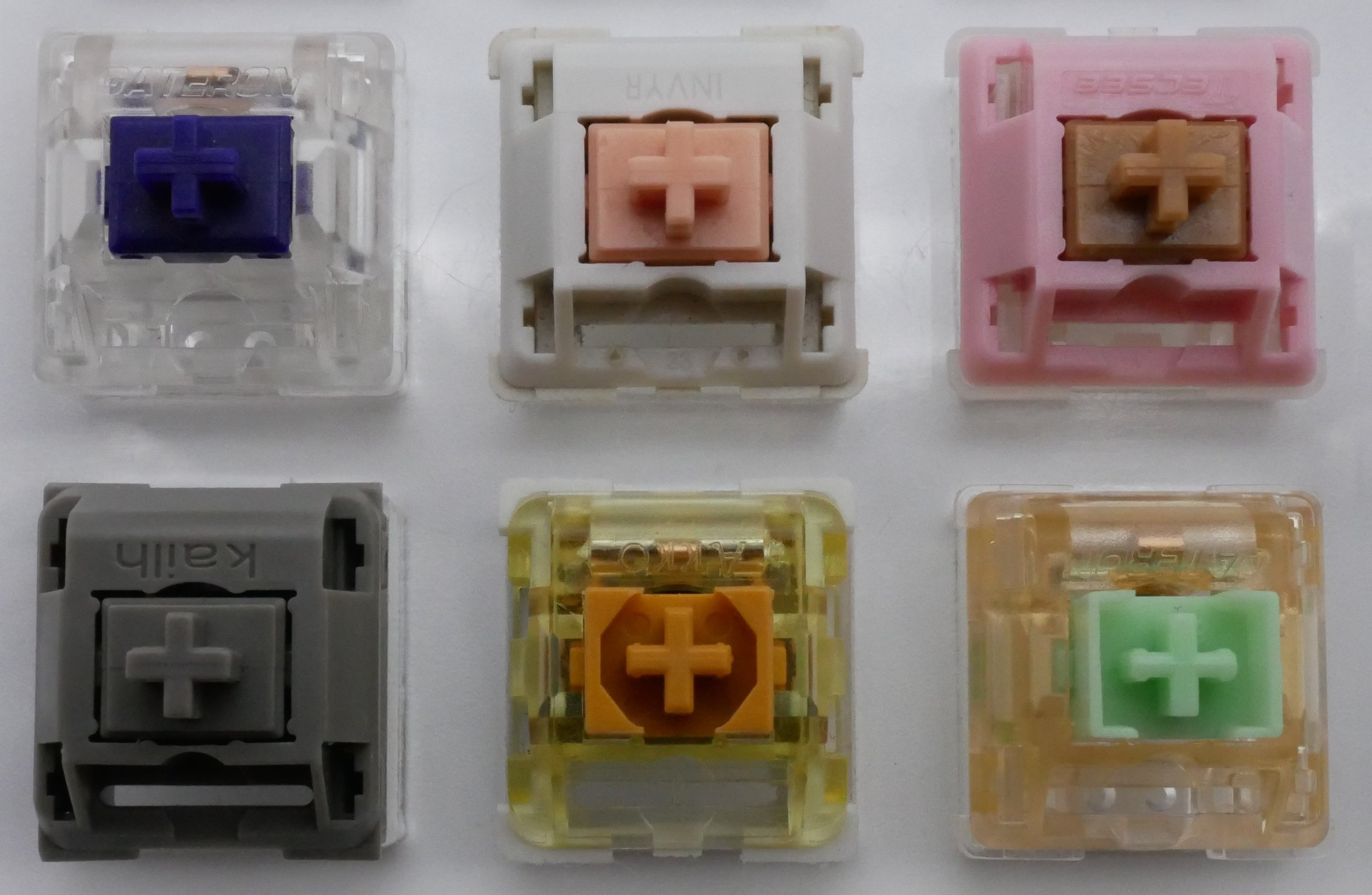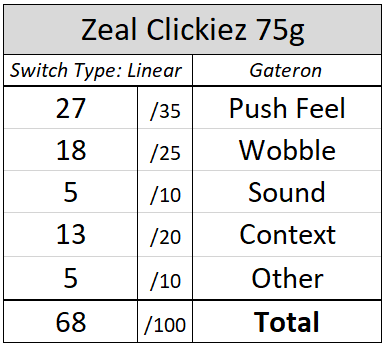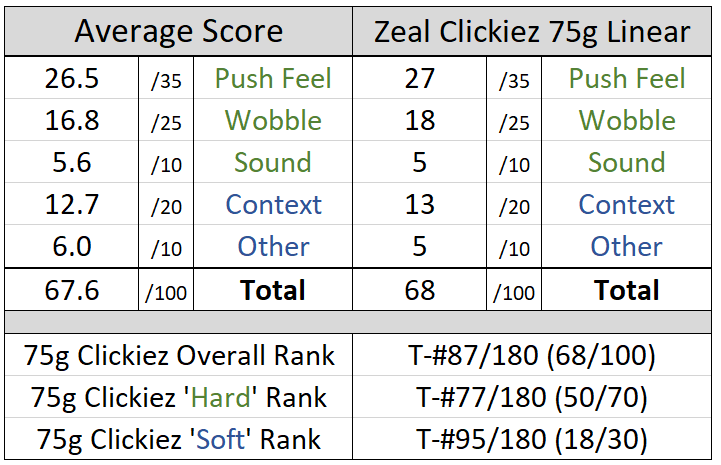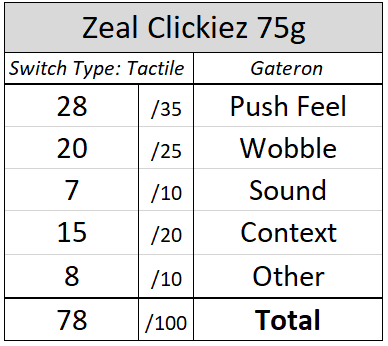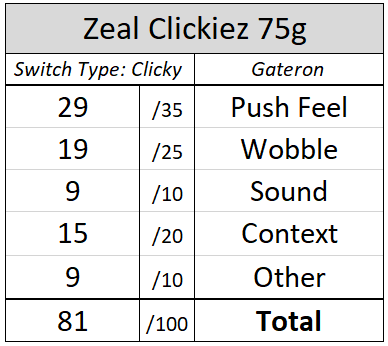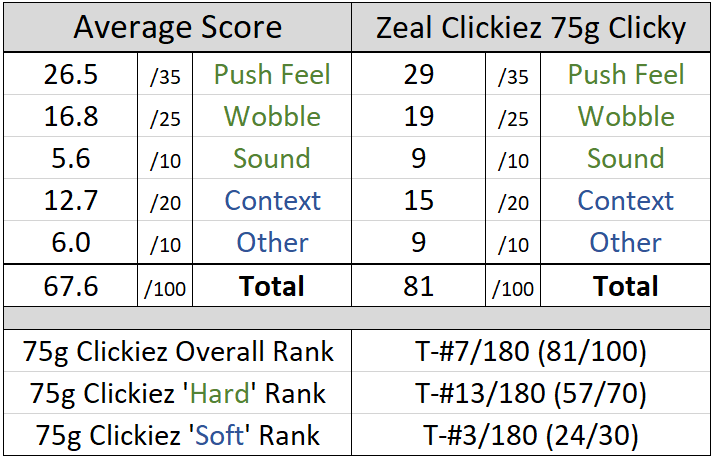Zeal 3-in-1 Clickiez Switch Review
Note: In order to keep everything as fully transparent as possible, I feel inclined to inform all readers that I am sponsored by Zeal as of the time of writing this review. With that in mind, though, the switches reviewed here were purchased of my own accord during the same pre-order phase as everyone else and with no discussion with Zeal prior to doing such. Zeal was not informed that this review would be completed in any way, shape, nor form, and had no editorial power with respect to such. All opinions here, as long winded as they may be, are expressly mine and mine alone.
I hope that you brought lunch and a friend to this review because this is going to be quite the long one. Before diving into the incredibly complex switch that is the Zeal 3-in-1 Clickiez, I do want to start off this review with a brief announcement about some upcoming content of mine that I’m sure you all will want to check out. Instead of the usual repository of measurements, or semi-long and incoherent ramblings in the form of a non-review-based articles, I’ve chosen to accept the challenge thrown down (several months ago now) by anaolivetree of the Cannonkeys team and will take part in a blind switch identification challenge live on Twitch on July 21st starting at 8 PM EST. You can feel free to pretend that I was called out only days rather than months ago as if I wasn’t meticulously studying the switch offerings over at Cannonkeys in that span of time…
Figure 1: Doesn’t the phrase go something like ‘April is the new July’?
All jokes about intensive, sommelier-esque training aside I’m looking super forward to the challenge and hope you all will join me there for a fun few hours of switches and discussions about such. In addition to trying to blindly identify switches in a Bakeneko by only sound and feeling alone, I’m going to have some ‘Q&A’ time, a short bit of time to flex my collection and keyboards off, and something like hundreds of switches to giveaway to lucky winners all before the end of the night and perhaps tanking my public perception irreparably. While I’m still hashing out some final details surrounding all of this in the final few weeks to go, I have been hard at work behind the scenes for some time now and can’t possibly wait to thank all the people, sponsors, and vendors which have all pitched in to make this stream awesome already. And I’m still excited about all of the switches too in case you were worried that I had forgotten about those!
Switch Background
Prior to starting a discussion of the background of the Zeal 3-in-1 Clickiez switches, it should be noted that the majority of the pre-release history of these switches exists primarily on Zeal’s Discord server and other content creators’ work and thus is subject to some level of ‘telephone game’ translation error. While historically Zeal has posted teasers, interest checks, and details about his switches on Geekhack primarily, a shifting in the most active location of the keyboard community at large away from forums such as Geekhack in favor of more interactive platforms such as Discord ostensibly pushed this parallel shift by Zeal. For a further discussion of what other switches have since been released in the ‘Zeal Discord’ era, please check out the Zealio V1 Redux Switch Review where I have touched upon the history of switches released by Zeal through the end of 2021.
The first public appearance of any advertisement or mention of the Zeal Clickiez switches came by way of a detail barren post on Zeal’s Discord announcement channel and related social media on January 6th of 2020. Consisting of only a single photograph of a lone Gateron switch with an orange stem and outwardly different top housing structure, this would later go on to be known as the first Zeal 3-in-1 Clickiez prototype switch which has since been seen only once more in other keyboard creator content discussed below. Further curiosity regarding the orange-stemmed prototype switch, though, would be left unanswered for several months until the next teaser which came on May 20th by way of an Instagram story. Consisting of a poll between two different stem colors of ‘Minty Green’ and ‘Highlighter Yellow’, this teaser also went on to share that the name of the new upcoming switch from Zeal was ‘Clickiez’. While the results of the Instagram story have since been lost to time, color-based reactions from Zeal’s Discord server have made abundantly clear that Minty Green was the community’s favorite at large.
Figure 2: First Zeal 3-in-1 Clickiez switch prototype photo featuring an orange stem.
Figure 3: Zeal 3-in-1 ‘Clickiez’ switch prototyping poll asking for community opinion on future stem color.
In the hours that followed the May 20th announcement of the ‘Clickiez’ switch name, discussion amongst switch collectors ran a bit wild with speculation as to what exactly these new switches could be. Having completely missed the slightly different top housing design in both of the announcement photos myself, I was of the camp that Zeal had finally gotten around to exhuming the design of the famous clicky Artistotle stems and had repurposed them in a modern switch design. Having previously been known for both his linear and tactile switches, many users have since forgotten that Zeal had first been interested in adding a clicky switch to his offering lineup several years prior, going all the way back to late 2015. Stretching all the way back in time to before the release of the 78g weighting for the Zealios switches, a Geekhack thread was started by Zeal titled “Clicky Zealio with a twist” discussing his interest in modifying the old Artistotle stems into that of a ‘modern Zealio switch’ that was “not going to resemble anything close to what Cherry or Gateron has to offer”. While the thread had picked up some small amount of interest at the time, it and design-related difficulties with respect to manufacturing and costs of the design effectively led to the permanent shelving of the plan in early April of 2016 by Zeal.
Figure 4: April 6th, 2016, announcement permanently shelving progress on a clicky Zealio switch.
I do want to rather stress that this historically-supported suspicion of mine did really last on the order of merely hours, though, as the very next day Zeal blew away my ideas with another Instagram story update. In a slightly more satirical poll format than the previous day’s decision, Zeal announced that the Clickiez switches were slated to be the “world’s first 3-in-1 switch” with the community options of ‘Count Me In!’ and ‘Bullshit’ to choose from on May 21st of 2020. While I was slightly off base with respect to which historical switch discussion I was going to have to refer to the first time around, I wasn’t going to be fooled again and joined the other 44% of people immediately calling bullshit on the claim via the Instagram poll. Even though these were most certainly not going to be the Zealistotles of 2015 that I had initially imagined these to be, I definitely did not forget about the other modifiable, click leaf-based MX switch that Zeal clearly counted out in his zealous marketing tactics: ProWorld Clickies.
Figure 5: This photo almost feels like one of those ham-fisted, ‘oLd MeEts NeW’ TV crossover events.
First documented by Geekhack user 2ter back in 2013, ProWorld Clickies are a vintage MX-style clone switch which feature a similarly large and boxy appearance as that of the modern Clickiez switches. Omitting the through-switch LED slot in a very unusual fashion for MX-style clones of the late 1980’s / early 1990’s when these were believed to be manufactured, the ProWorld Clickies feature a very similar internal click leaf design which could be adjusted from the switch in order to change the switch between clicky and linear modes. While the manufacturer of the ProWorld switches is to this day unknown, with only vague implications as having been associated with a company by the name of ‘PodWorld’ remaining, these switches are only found in a very narrow range IBM Model F-AT inspired clones such as the SKB-5150C. For a further discussion on the ProWorld Clicky switches, I would highly recommend watching both TheInverseKey and Chyrosran22’s Clickiez switch videos as they too discuss this switch. It should also be noted, as well, that TheInverseKey was involved in the development of the Clickiez switches and also shows proof of life for the orange Clickiez prototype in said video.
Figure 6: ProWorld Clicky switch components with click leaf installed in operating position from Deskthority.
Returning from yet another historical switch tangent, further updates regarding the progress of the Clickiez switches were few and far between following the May 21st, 2020 announcement. While Zeal did occasionally discuss the switches in various channels on his Discord, as well as made a brief proof-of-life announcement in September of 2020, it wasn’t until their pre-order announcement on December 26th of 2021 that the Clickiez would be mentioned again in detail. Apparently completely disregarding the initial advertising poll, the Clickiez were released alongside the Pearlio and Crystal switches in ‘60g’ Minty Green and ‘100g’ Highlighter Yellow variants, with the weights referring to their actuation force. A few months later in January of 2022, a naming convention change occurred in which the switches were renamed with respect to their bottoming out weight, like the rest of Zeal’s switches, making the Minty Green switches ‘40g’ and the Highlighter Yellows ‘75g’ in name. Regardless of their naming scheme, the switches were sold at a preorder price of $13.00 per 10 pack of switches with subsequent, in-stock releases increasing in price to $15.00 per 10 pack, effectively making them among the most expensive, stock MX-style switches to ever be released. While the price alone is indicative of a large amount of R&D placed into the switches prior to their release, further claims by Zeal that the design of the Clickiez switches’ click leaf mechanism are ‘patent pending’ as of the time of writing this review further support this claim. Shipments of the original pre-order sales of Clickiez switches did not begin arriving to customers until late Q2 of 2022, ostensibly due in part to COVID and supply-chain related issues which plagued much of the keyboard community during those years.
Figure 7: Clickiez switch weight name change announcement from the Zeal Discord announcements channel.
Clickiez Switch Performance
Note: The Zeal Clickiez switches come in both 40g and 75g variants. For the review conducted in the following sections, I will be reviewing the 75g variant of the switches in linear, tactile, and clicky modes. Any discussion surrounding the 40g variants will be clearly marked and/or made evident.
Appearance
At the highest level, the Zeal 3-in-1 Clickiez switches, which will be shortened as ‘Clickiez’ for the rest of this review, come in two different varieties denoting differences in spring weighting. The lighter-weighted, 40g at bottoming out variants come in ‘Mint Green’ whereas the heavier, 75g at bottoming out variants come in ‘Highlighter Yellow/Neon Yellow’. While fitting the MX footprint with a 5-pin, Gateron CAP style bottom housing, the top housing and overall shape of the Clickiez switches is radically different than other modern MX switches in order to accommodate the click leaf and is distinctive on this point alone. Further internal and external distinguishing features, especially with respect to other Gateron CAP style switches, will be covered in the paragraphs below.
Figure 8: Zeal Clickiez switches and their components.
Looking first to the polycarbonate top housings of the Clickiez switches, they are distinctively more ‘boxy’ and large in size than normal, MX style top housings. Featuring a secondary nameplate region in the location where the LED slot would normally be on an MX style switch, the Clickiez feature two upward facing nameplates and are among the few modern switches to feature more than one branding impression on the top housing. (While the engravings on the sides of the TTC x Helix Lab Skylar and TTC Ace housings are not strictly nameplates in design, they feature as a secondary distinguishing mark in addition to the TTC nameplate.) The south-side nameplate region features an outward facing, right side up stylized ‘ZEAL’ logo whereas the north-side nameplate region features a flipped ‘GATERON’ nameplate in line with most of their designs over the course of the past year of releases. Both nameplates feature raised letters with the Gateron carrying a significantly thicker font to it.
Figure 9: Family photo of modern, MX style switches featuring multiple top housing engravings including TTC Ace (Top Left), TTC x Helix Lab Skylar (Top Right), and Zeal Clickiez 75g. (Front Center).
Internally, the polycarbonate top housings are not all that special in design even taking into consideration the included space where the through-switch LED would be placed. Whereas the slider rail topping out and north-side nameplate region remain in line with design standards for Gateron switches, the region underneath the south-side nameplate region is completely barren of detail to allow for full motion and actuation of the click leaf depending on the mode it is in. The Tactile mode, for example, shows the leaf pressed more into the upper corner of this region than the Clicky mode. Interestingly, the mold marking on the Clickiez top housings is located in the upper left-hand side underneath the north-side nameplate region and is a single capital letter in design. Whereas most modern switches with internal top housing mold marks have them located in only the right-hand or both sides, only Gateron CAP style switches have them located in the upper left-hand side as far as I can recall.
Figure 10: Clickiez top housing internals showing cavernous region below south-side nameplate to accommodate the click leaf when installed.
Figure 11: Clickiez top housing internals showing single capital letter mold marking in top left corner underneath the north-side nameplate region.
Figure 12: Side view of 40g. Clickiez switches in Clicky (Left) and Tactile (Right) modes showing difference in click leaf location within the top housing.
Moving next to the stems and springs of the Clickiez switches, it should be noted that these do not come with any significant amount of factory lubrication applied to them at all. While there is very minor amounts of lube applied to the interface between the normal leaf/leg interface, it is rather difficult to photograph and not all that fundamentally important to the design of the switch. As is implied multiple prior times when referring to the CAP style of the Clickiez switches, the stems are flipped from traditional MX-style stems and feature a central pole hole which slides over a fixed mast in the bottom housing. As a result of this design feature, the springs in the CAP switches are of a significantly wider gauge and cannot be used interchangeably with non-CAP style MX switches. Beyond this increased gauge, though, the springs do not appear significantly different than other springs and are identical in color and threading to that of the Gateron CAP Yellow switch springs.
Aside the CAP design of the stems, they appear more or less normal with respect to design based features. Coming with a non-tapered set of slider rails and front-set, tiny mold ejector circles they appear more or less similar to CAP Yellow stems save for two interesting features. The first feature worth noting is that the backplate of the Clickiez switches is squared off whereas in other CAP stems the corners feature slanted edges. The flattened edges of the backplate design for the Clickiez stems is crucial for interacting with the click leaf when in Tactile mode and would not work the same without this shape. The second, and much more subtle design difference in the Clickiez stems is that they feature an extremely subtle ribbing inside the hole of their stem, in a similar fashion to how some modern, non-Gateron switches have added to their bottom housings. The Gateron CAP Yellow switches which I’ve used for comparison in this section do not have this feature.
Figure 13: Clickiez 75g. stem showing squared off backplate, non-tapered slider rails, and CAP like central pole design.
Figure 14: Alternative angle of the 75g. Clickiez stem showing faint ribbing in the interior of the central pole.
Coming next to the click leaf of the Clickiez switches, these are by far the most challenging piece for me to describe. Consisting of a single piece of bent steel, these sit in the bottom housings of the Clickiez in two different locations depending on which mode the switch is to be in and have slightly different functionality of the result. In terms of shape, the leaf has a flat rectangular region which sits in the various grooves of the bottom housing and positions the downwardly angled portion towards the stem to interact upon pressing. At the end of the downwardly angled region there is a differently angled pair of ‘teeth’ which interfaces with the stem differently depending on the leaf configuration. As has been shown below in Figure 15, which is a diagram based on Chyrosran22’s Clickiez review video, in the Clicky mode, the click leaf sits perfectly upright and undergoes much less compression than the Tactile mode, which is achieved when the base of the click leaf is placed on the inside of the bottom housing groove and leaned backwards into the housing. In their stock form, the click leaves sit in the bottom housings very loosely and are liable to easily fall out or move if not carefully assembled and/or disassembled.
Figure 15: Diagram comparison of location of click leaf (grey, left) in Clicky and Tactile modes and how the angle of contact with the stem changes.
Figure 16: Top down, visual representation of click leaf location in Clickiez in Clicky (Left) and Tactile (Right) modes.
Finally arriving at the nylon bottom housings of the Clickiez switches, these appear different than previous CAP style switches from Gateron, but in rather subtle ways. Internally, the switches feature a slightly padded bottoming out region for both slider rails as well as a deep well around the center mast for the stem to sit in upon full compression. Like previous CAP switch iterations, the center mast in the bottom housing does feature a tiny hole in the top of the mast, though it is much harder to see due to the clear plastic nature of the housings. An additional unique feature is that of the two slots for the clicky leaf placement in the bottom housing of the Clickiez switches. Whereas normal, non-modifiable switches have a much larger dividing wall to separate the switch internals from the LED slot region, the wall in the Clickiez is much shorter and is simply present to hold the leaf up in various configurations. In the stock, Clicky mode, the click leaf sits behind the dividing wall on the ‘outside’ of the groove and further towards the wall of the bottom housing. In the Tactile mode, the base of the click leaf is moved inside of the wall into a small groove, and then leaned back over this dividing wall.
Figure 17: Clickiez bottom housing internals showing the moat around the central mast and padded bottoming out regions underneath the slider rails.
Figure 18: Alternative angle of Clickiez bottom housing internals emphasizing shortened height of dividing wall between Tactile and Clicky mode grooves for the click leaf.
Externally, the bottom housings are by far the most mundane design point of the entire switch and are nearly identical to that of previously ran Gateron CAP switches. In addition to the PCB mounting pins, the bottom housings feature a pair of capital letter mold markings in the bottom left- and right-hand sides in between the holes that would normally be for diodes and LEDs in a normal switch design. As well, the Clickiez switches feature the sideways ‘GATERON’ anticounterfeit stamp, something of which has been present on most modern iteration of Gateron and Zeal switches, ostensibly to signal upgraded mold designs like the inverted top housing nameplate as well as in response to the Stealios Controversy.
Figure 19: Clickiez bottom housing externals showing capital letter mold markings as well as ‘GATERON’ anticounterfeit marking.
Push Feel
Due to the fact that two of the three modes for Clickiez switches are accessed through opening and modification of a decently fragile and unsecured component in the click leaf, there is admittedly more variability in user experience of the Linear and Tactile modes. (Clicky is the stock mode of the Clickiez switches.) In an attempt to verify, at least for my own sanity, that this variation between switches is minimal at best, I picked three of each mode at random and conducted force curves on each of them in order to see if there was a noticeable difference between the force curves of each of the switches. As can be seen below in Figures 20 through 22, there does not appear to be a significant difference, on average, between various switches of the same mode even after modification. Note, there is no key on these figures as each switch is represented with a slightly different shade of the same red/orange color.
Figure 20: Force curve comparison for 3 different 75g. Clickiez switches in Linear mode.
Figure 21: Force curve comparison for 3 different 75g. Clickiez switches in Tactile mode.
Figure 22: Force curve comparison for 3 different 75g. Clickiez switches in Clicky mode.
Linear:
In the Linear mode, the Clickiez switches are by far the most similar in feeling to that of a normal, standard linear MX style switch. While decently smooth throughout the stroke for being factory unlubed, there is a slight amount of small grain scratch that is consistent throughout the stroke and across the batch that could be easily removed with a light lube application. Much like other Zeal switches, the Linear mode Clickiez suffer a bit from a thin, polycarbonate topping out which gives a slightly thin and plasticky feeling upon the stem’s return. Unlike other Zeal switches, though, this thin topping out isn’t strongly juxtaposed with a deep, firm bottoming out and instead the Clickiez in Linear mode have a much more polycarbonate-esque bottoming out that is slightly less thin and sharp than the topping out.
Comparing the 40g Linear mode Clickiez to that of the 75g ones, however, I would say that a lot of the less savory aspects in the previous paragraph are toned down quite a bit. While the smoothness and small grain scratch is more or less the same, due to the lighter spring weight of the 40g switches, the housing collisions are much less strong and consequently produce a much more solid feeling than that of the 75g switches. Interestingly, though, the 40g Linear mode switches suffered a bit more with variability than that of 75g ones, and specifically with respect to the topping out. In the three trials which I conducted, two of the three had a ‘zero return force’ topping out as can be seen below in Figure 24 whereas the third did not. I was not able to determine exactly what the cause of this variability was but it certainly does verify that the 40g switches top out with less force than the 75g ones.
Figure 24: Force curve comparison for 3 different 40g. Clickiez switches in Linear mode demonstrating disparity in upstroke return weight.
Tactile:
At normal actuation speeds, the Tactile mode 75g Clickiez feel rather poppy, sudden, and front loaded in terms of their tactile bump. While one is able to subtly pick up the entirety of the tactile bump and the transition into the post-bump linear region at very slow activation speeds, the large tactile bump force around 115g. makes it really hard to be able to pick out the start of the linear region around 50g of force at any normal typing speeds. Because of this large force difference, without looking at the force curve one may be inclined to think that the tactile bump is significantly larger, and would nearly take up the entirety of the downstroke, popping back with an equivalently large and slightly lighter force. While may other highly tactile switches have certainly punched into a similar region of force as the 75g Clickiez, the apparent size of the bump matched with the force makes the overall bump feel significantly more forceful than that of other tactile switches. These are definitely not the tactiles for weak fingered users like me.
Regarding the rest of the switch’s feeling in the Tactile mode, there are a surprising amount of differences from that of the Linear mode described above. The first striking difference is that of a significantly scratchier stroke which is due to the increased surface area of contact between the stem and the click leaf mechanism. As was shown above in Figure 15, recall that the squared off edges of the backplate of the stem contact the leaf teeth significantly more head on, producing a greater area of contact and assumedly thus more scratch as both of these components are unlubed. The consistency in the magnitude of increase in scratchiness for the 40g variant, as well, confirms to me this is a function of the stem/click leaf interaction rather than some mysterious spring-weight based rationale. Additionally, the housing collisions are a lot more subtle and hard to pick out here in terms of feeling. With such a large tactile force located towards the very start of the downstroke, the bottoming out is almost inconsequentially light and the topping out blends into the bump in terms of overall feeling.
Clicky:
Regarding the force curve for the Clicky mode of the 75g Clickiez, its rather reasonable that a comparison could be made to the Tactile mode insofar that the Clicky mode is a sort of ‘baby tactile mode’ in feeling. While the tactile bump in the Clicky mode is not quite nearly as forceful, its location, size proportional to the post bump linear region, and mechanism of action with the click leaf all lead to a relatively similar feeling but toned-down bump in both of the spring weights that mimics that of the force curve-based expectations quite well. The points at which these two modes do differ, though, are subtle but present. The first is that of the lead up to the tactile bump – whereas the Tactile mode had no linear pre-travel, there is an ever so slight build up to the bump in the Clicky mode which is a bit unpleasant. As well, the topping out is ever so slightly more present as a background feeling to the bump in Clicky mode, producing a much more firm returning bump than the downstroke one.
Sound
Linear:
Exactly as could be expected for the Sound section of the Linear mode Clickiez, these switches sound almost spot on the same as their ‘Push Feel’ notes above. While there is a subtle scratching noise that isn’t the most overwhelming of sounds, it is still present enough that hollow cases and/or thin keycap sets may accentuate this sound quite a bit when using them in a keyboard. As for the housing collisions, the 75g Clickiez had very prototypical thin, sharp, and plasticky sounding polycarbonate housing collisions. Unlike other previous iterations of Zeal linears, though, there doesn’t appear to be any noticeable spring ping at any actuation speeds in stock form.
In a very surprising fashion, though, the Linear mode 40g Clickiez switches are significantly more quiet than that of the 75g variants. While all of the same features are present in the 40g variants that were described above for the 75g ones, its to such a significantly turned down degree that one would assume these to be two entirely different switches based on sound, alone.
Tactile:
Due to the relatively large apparent tactile bump in the 75g Clickiez, the sound profile of these switches in Tactile mode is one nearly entirely based around the tactile bump. Whereas the bottoming out is impossible to discern here by comparison, the topping out is equally hard to track as it melds into the large, rounded, and punchy tactile bump sound. Even with an overarching scratch sound as a function of the stem/click leaf interaction, the tactile bump occupies a middle ground in both volume and tone and carries just the slightest hint of a sharpened edge. Through the scratch it would not be wrong to characterize these as extremely rounded in terms of their overall sound profile.
Clicky:
In terms of sound, the Clicky mode of the 75g Clickiez is truly a sight to behold for the MX footprint of switches. Not only do these sound extremely loud in terms of overall volume, they have a rather complex, full-bodied sound to them is sharp at the tip but rounded and almost sonorous at the bottom. The immediate comparison to Alps style switches in already published reviews of the Clickiez is completely a fair one, not so much because they necessarily sound like Alps clickies, but because they sound so distinctly different than even gold standard, clickbar style clickies like Box Jades or Box Navies. Interestingly, as well, the slightly rounded, sweet undertone to the bump of the Clickiez actually grows in terms of presence and volume at higher activation speeds purely in hand and without any assistance from a keyboard case design.
Wobble
In terms of stem wobble, there is some level of variation between the various modes of the Clickiez switches that is a function of the click leaf placement within them. Going from least wobbly to most wobbly, the order of stem wobble is that of the Tactile mode, followed by the Clicky mode, and then finally with the Linear mode. This trend can rather easily be explained as a function of how much direct, vertical contact is made between the stem and the click leaf in the resting position, with the most wobbly mode not having the click leaf present at all. Regardless of which mode is used, however, all switches have a very small amount of equivalent magnitude wobble in both N/S and E/W directions that would likely not be problematic unless the user is particularly sensitive with respect to stem wobble.
Measurements
If you’re into this level of detail about your switches, you should know that I have a switch measurement sheet that logs all of this data, as well as many other cool features which can be found under the ‘Archive’ tab at the top of this page or by clicking on the card above. Known as the ‘Measurement Sheet’, this sheet typically gets updated weekly and aims to take physical measurements of various switch components to compare mold designs on a brand-by-brand basis as well as provide a rough frankenswitching estimation sheet for combining various stems and top housings. Do note, though, that this switch will not be included on this sheet due to the CAP design being incompatible with the majority of MX style stems for frankenswitching purposes.
Break In
Linear:
Break In Notes:
17,000 Actuations
- Unlike both the Clicky and Tactile modes, the Linear mode of the Clickiez did not appear to significantly change their stem wobble at 17,000 actuations. Why this is the case for these and not the others I’m not entirely certain of, but I’d wager a guess that it has to do with a lack of involvement with the loosely held click leaf.
- As well, both weightings of the Clickiez switches improved subtly in terms of smoothness in both push feeling and sound when actuated out to 17,000 actuations in the Linear mode. While I doubt this would be as noticeable if aftermarket lubrication was put on the stems of the switches prior to breaking them in, it is noticeable enough in their stock format.
34,000 Actuations
- At 34,000 actuations, both weights of the Clickiez switches in the Linear mode appear to remain resilient to stem wobble changes. The stem wobble is nearly identical to that of both the 17,000 actuations and stock versions of the switches.
- As for the push feeling of the switches, while the smoothness increase over the stock form is consistent with the 17,000 actuations trial, the switches have picked up a slightly more ‘hollow’ feeling. The 40g Clickiez, in particular, began to feel much more loose almost underweighted throughout the stroke at this many actuations.
51,000 Actuations
- While having the most wobble in their stock form, the Linear mode Clickiez interestingly didn’t change in terms of stem wobble until 51,000 actuations when compared against their stock form.
- Regarding the hollowness and thinness that was mentioned previously at 34,000 actuations, it is certainly still present at 51,000 actuations but much more tolerable. Perhaps due to slightly improved smoothness in terms of both sound and push feel, the slightly more flimsy feeling switches feel much more coherent and as if they were designed to feel that ‘airy’ versus that of their strange feeling at 34,000 actuations. Or perhaps I just got used to it, who the hell knows.
Tactile:
Break In Notes:
17,000 Actuations
- Unlike the Clicky mode, the Tactile mode Clickiez were actually worse with respect to smoothness in both push feel and sound after 17,000 actuations. I suspect this is due in some significant part to het fact that the stem/leaf interaction surface area is significantly larger in the Tactile mode and thus harder to ‘wear smooth’ in such a short amount of time.
- Stem wobble in both N/S and E/W directions increased as expected regardless of the weight of the Clickiez switch tested.
34,000 Actuations
- Interestingly, as further actuations are put on the Clickiez switches in Tactile mode, they appear to suffer even more with the exact same issues as noted above at 17,000 actuations. The amount of scratch is especially present in the push feeling of the switches, and is noteworthy compared to sound.
- The increased scratchiness in feeling, in particular, at least anecdotally supports my idea that it is a function of the increased surface area between the stems and the leaves which are causing the most issues here.
51,000 Actuations
- At 51,000 actuations, all of the noted issues of the past two hours of break in testing are still present and marginally worse in the Tactile mode Clickiez. I am not entirely certain how these switches appear to get worse with actuations through these few hours of testing, but I am very curious how much worse they get with extended periods of usage.
- At 51,000 actuations, the Tactile mode Clickiez of both weights begin to pick up a sort of grippy and/or sticky like feeling as if moving away from the top housing, and ostensibly through the tactile leaf) is becoming harder than it was at prior activation points or in their stock form.
Clicky:
Break In Notes:
17,000 Actuations
- At 17,000 actuations, the Clicky mode of these switches improves with respect to the smoothness of the overall sound but not the spring ping. Whereas the stock form of both weights has a slight graininess to the interaction between the stem legs and the click leaf, this more or less disappears this far into the break in.
- Not all that surprisingly, the stem wobble for both weights of Clickiez increases in both directions after 17,000 actuations. This is more or less the norm for switches to increase their stem wobble upon being broken in.
34,000 Actuations
- Much like with the other Clickiez modes, the Clicky mode appeared to have the same flaws at 34,000 actuations that were present at 17,000 actuations. However, they did not progress nor get distinctly worse than the 17,000 actuations switches.
- Interestingly, as the break in is increased to 34,000 actuations, the Clicky mode Clickiez lose a bit of the sharpness in feeling and sound of the clicky bump and make for a slightly less grating feeling and sound to the leaf/leg interaction.
51,000 Actuations
- Compared to their stock form, the Clickiez switches in Clicky mode take a rapid turn in terms of their sound at 51,000 actuations and become sort of hollowed out. While the sharpness in the actual click mechanism is still present, a good amount of the full-bodied like nature of the sound is completely absent at this point.
- Unlike the Tactile mode switches, the Clicky mode switches actually improve ever so slightly at 51,000 actuations in terms of smoothness and spring with respect to their push feeling.
Other
Figure 31: Have a rest, dear reader, the fire is warm.
Welcome to the place of respite, dear weary reader. If you’ve actually read this deeply into the review and haven’t skipped past any sections up to this point you deserve a medal. Did you know that as of at least the past year that Zeal has been providing miniature sized Coffee Crisps in each one of his switch packages? Not being able to walk down to the corner store and buy those here in Minneapolis, I find them a stupidly delicious treat regardless of how melted they are when they arrive. With each subsequent package of Zeal switches arriving, I become more and more tempted than ever to import an entire box of them across the border and lounge around on a weekend eating them instead of writing content. You know that I wouldn’t do that though since I spend all of my free cash and time on switches.
Figure 32: Some of the best candy I’ve ever received in any switch package, hands down.
Oh, and another thing worth mentioning here: people who love to modify switches are going to have a damned field day trying out all of the wild and crazy combinations they can with these switches. Even though the Clickiez switches are built in the CAP layout, which admittedly has a relatively narrow selection of offerings, people in servers I’m in have tried swapping tactile stems into the place of Zeal Clickiez stems as well as found that you can actually fit the click leaves into the bottom housings of other CAP switches. As for the feeling of these things, well let me just show you the force curves as it would be nearly impossible for me to pay justice to without another full review.
Comparison Notes to Other Notable Switches
Note – These are not aimed at being comprehensive comparisons between all factors of these switches as this would simply be too long for this writeup. These are little notes of interest I generated when comparing these switches to the Clickiez side by side.
Linear:
Figure 35: Switches for comparisons in the linear mode. (L-R, Top-Bot: Novelkeys Cream Arc, Akko CS Jelly Black, Gateron CAP Yellow V2, SP Star Sacramento, Designer Studio Graphite Gold, and Invokeys Matcha Latte)
If you would like to learn more about these switches, I’ve already completed reviews or scorecards for some of them. If the names below are highlighted in a grey color, click them to be taken to my other content or reviews on them!
Novelkeys Cream Arc
- Due to the progressive nature of the springs of the Novelkeys Cream Arcs, they feel significantly heavier and more solid than that of the Linear mode 75g. Clickiez switches.
- In terms of stem wobble, even though the 75g Clickiez have the largest amount of stem wobble of any of the various Clickiez modes, its still pretty similar to that of the Novelkeys Cream Arcs, if not marginally better.
- While both switches are scratchy throughout their stroke, the Cream Arcs have a much more sandpaper-like grit to their scratch as compared to the very fine grain, subtle scratch of the Clickiez in linear mode.
Akko CS Jelly Black
- Of all of the switches on this comparison list for the Linear mode 75g Clickiez, this is the only switch which is significantly louder than the Clickiez. That being said, though, the overall sound is still not nearly as sharp as that of the topping out of the Clickiez.
- The Akko CS Jelly Blacks are marginally better than the Linear mode Clickiez in both N/S and E/W direction stem wobble.
- Interestingly, while the topping outs between the two switches sound drastically different, they are actually the most similar feeling out of any of the switches in this linear comparison list.
Gateron CAP Yellow V2
- The Gateron CAP Yellow V2s are ever so slightly smoother throughout the entirety of their stroke than that of the stock, Linear mode 75g. Clickiez switches. With any amount of aftermarket lubrication, however, this would be effectively a coin toss to figure out which would be smoother.
- The CAP Yellow V2s, however, are noticeably better in both N/S and E/W direction stem wobble than that of the Clickiez switches in Linear mode.
- The housing collisions, and especially that of the topping out of the Yellow V2s is much more firm and solid feeling as compared to either of the housing collisions in the Clickiez switches.
SP Star Sacramento
- Comparing their stock push feeling against each other, these switches are the most similar to each other in terms of raw scratchiness out of any of the other comparisons on this list.
- The SP Star Sacramentos are much better than the Linear mode Clickiez switches in terms of N/S and E/W direction stem wobble.
- In a similar fashion to the comparisons made above for the CAP Yellow V2 switches, the Sacramentos have a much more solid and firm feeling set of housing collisions to them than the Clickiez switches, something which is likely explainable by a difference in housing material between the two switches.
Designer Studio Graphite Gold
- Even at super-fast activation speeds, the Graphite Gold switches feel and sound significantly more muted than that of either the 75g or the 40g Clickiez switches in Linear mode.
- The stem wobble is a bit better in the Clickiez switches in Linear mode than in the Designer Studio Graphite Gold switches. They also are much less variable across the batches received than the Graphite Golds.
- At higher activation speeds, though, while the Graphite Golds still feel much more muted than that of the Clickiez switches, they begin to pick up a tiny bit of thinness in the topping out which isn’t present at normal typing speeds.
Invokeys Matcha Latte
- The factory lubing on the Invokeys Matcha Lattes almost isn’t even a fair comparison here as it absolutely blows out the 75g. Clickiez in terms of smoothness.
- The Matcha Lattes not only have less stem wobble than the Linear mode 75g. Clickiez switches, but all three modes of the Clickiez switches. (The comparison with the Tactile mode is much more narrow though than you would think.)
- The bottoming out of the Clickiez switches is much less noticeable than that of the Matcha Lattes, even when attempting to bottom them out with some level of prejudice.
Tactile:
Figure 42: Switches for comparison in the tactile mode. (L-R, Top-Bot: Zealio V2 AC (78g), Invyr Holy Panda, Neapolitan Ice Cream, Novelkeys Cream Tactile, Akko CS Sponge, and Gateron Kangaroo Ink)
Zealio V2 AC (78g.)
- While the tactile bump is located at the top of the downstroke in both of these switches, there is a minor amount of linear pre-travel up to the tactile bump of the Zealio V2s that isn’t present in the 75g. Clickiez.
- In terms of sound, the 75g. Clickiez in Tactile mode are much more snappy, sharp, and overall significantly louder than the tactile bump of the Zealios V2 switches.
- There is a similar type of scratch feeling between the two switches, though I feel as if the Zealio V2 switches are just a tiny bit more scratchy than that of the Clickiez.
Invyr Holy Panda
- The tactile bump of the Clickiez switches makes the original Holy Pandas feel small and relatively weak in comparison. Even keeping the differences in peak force in mind, the size and relative presence of the Clickiez’s bump is completely unrivaled in terms of feeling compared to a relatively lauded highly tactile switch such as the OG Holy Pandas.
- Much like with the Zealio V2 comparison made above, there is a slight amount of linear pre-travel up to the tactile even in the Invyr Holy Pandas that is not present in the Tactile mode of the Clickiez switches.
- While these two switches have a similar amount of scratch to them, the Invyr Holy Pandas have a slightly larger grain, more noticeable scratch to them than that of the Clickiez switches.
Neapolitan Ice Cream
- The tactile bump of the Neapolitan Ice Cream switches, by comparison, isn’t anywhere near as punchy nor as strong as even the 40g. Clickiez switches. As you could imagine, the difference is only more drastic when comparing them to the 75g. Clickiez.
- There is a rather noticeable amount of spring ping in the Neapolitan Ice Cream switches which is simply lacking in any of the various modes of Clickiez switches.
- The Tactile mode Clickiez switches in both weights are noticeably more scratchy than that of the Neapolitan Ice Cream switches.
Akko CS Sponge
- While nowhere near the same ballpark in terms of tactile bump size, the amount of scratchiness that is felt by the leg/leaf interaction in the Akko CS Sponges switches is similar in magnitude to that of the scratch from the stem and click leaf of the Clickiez switches in Tactile mode.
- Comparing the sheer volume of the Clickiez switches next to the Akko CS Sponge, even at low activation speeds they sound like clicky switches next to that of the Akko CS Sponges at high activation speeds.
- The topping out feeling of the Akko CS Sponge switches is a tiny bit more firm, and definitely more present than that of the Clickiez switches.
Novelkeys Cream Tactile
- Of all of the switches in the tactile comparison list, the scratch of the Novelkeys Cream Tactiles is most similar to that of the scratch of the Clickiez switches in Tactile mode.
- The tactile bump of the Cream Tactiles might as well be the new MX Browns by comparison. I’m serious, the difference in hand is literally night and day.
- There is a pretty noticeable amount of spring ping in the Novelkeys Cream Tactile switches that simply isn’t present in any of the modes of the Clickiez switches and especially not the Tactile mode.
Gateron Kangaroo Ink
- Much like with the Novelkeys Cream Tactile comparison made only a few lines ago, the Kangaroo Inks have a spring ping that just flat out isn’t present in the Clickiez switches.
- While the tactile bump of the Kangaroo Inks feels decently close to the Clickiez in terms of size relative to the overall stroke length of the switch, the difference in overall peak force makes it difficult to even attempt this comparison.
- The Kangaroo Inks are better than the Tactile mode Clickiez switches with respect to both N/S and E/W direction stem wobble.
Clicky:
Figure 49: Switches for comparison in the clicky mode. (L-R, Top-Bot: Kailh Box Navy, Kailh Box Jade, Cherry MX Blue, Novelkeys Sherbet, ProWorld Clicky, and Kailh Arctic Fox)
Kailh Box Navy
- While the Kailh Box Navy tactile bump is much more clicky and pen like, there’s a sweet, rounded undertone to the Clickiez switches which adds so much more depth and complexity than one would get out of a Box Navy.
- In terms of overall volume, the two switches are relatively similar, though the difference in size of the sound makes the much sharper and narrower Kailh Box Navies feel more piercing to the ears.
- In a heads-up comparison, the tactile bump of the Box Navy’s click bar feels slightly more crinkly and less cohesive than that of the click jacket bump in the Clickiez switches in Clicky mode, which is quite surprising.
Kailh Box Jade
- The same comparisons that were made above regarding the relatively narrow and pointed sound of the Box Navies as compared to the Clicky mode Clickiez holds true here for the Box Jades as well.
- While significantly more polished and singular, the tone of the Box Jades is actually most similar to the Tactile mode, 40g. Clickiez switches, much to my surprise.
- Both the Box Jade and Box Navy switches feel significantly less ‘glass cannon’ like and thin than the Clickiez switches.
Cherry MX Blue
- To be entirely honest, the Cherry MX Blues sound like a factory assembly line defect when compared to the Clickiez switches in Clicky mode.
- There is a significantly more jumbled, grainy, and scratchy sound to the MX Blues which is worse than any of the other switches in this comparison list.
- At least the topping out of the Cherry MX Blues is more solid, as if that is much of a consolation prize or point of recognition in a clicky switch of all things.
Novelkeys Sherbet
- The Novelkeys Sherbets have a pretty substantial amount of spring ping that is especially noticeable when comparing them next to the Clicky mode Clickiez switches.
- In terms of overall volume, the Novelkeys Sherbets are surprisingly comparable to the 40g. Clickiez switch in Clicky mode, but slightly below that of the 75g. Clickiez.
- Funny enough, the Sherbets are noticeably better than the Clickiez switches in terms of both N/S and E/W direction stem wobble.
ProWorld Clicky
- In a similar fashion to the other click bar mechanism clickies on this list, the ProWorlds have a much more sharper, singular tone to them as compared to the more rounded, full-bodied sound of the Clickiez switches.
- Unlike both weightings of Clickiez switches, the actual bump mechanism in the ProWorlds sits a bit lower in the downstroke and is proceeded by a pre-bump linear region that feels roughly twice as large.
- Interestingly, the smoothness of both of these switches is more or less similar even though they were made by vastly different quality of manufacturers decades apart.
Kailh Arctic Fox
- Finally, a switch that is louder than both weights of the Clickiez switches in Clicky mode. And I don’t mean a tiny bit louder, either – the Arctic Foxes are drastically louder.
- While there is a tiny bit of a rounded undertone to the Kailh Arctic Foxes that give them a bit more character to their click than Box Jades or Box Navies, it’s still completely out of the league of the Clickiez switches.
- Even the tactile bump that accompanies the clicking mechanism of the Clickiez switches feels more full bodied and substantial than that of the Kailh Arctic Foxes.
Scores and Statistics
Note – These scores are not necessarily completely indicative of the nuanced review above. If you’ve skipped straight to this section, I can only recommend that you at least glance at the other sections above in order to get a stronger idea of my opinion about these switches.
Linear:
Push Feel
The Linear mode of the Clickiez switches is at best an average performing linear by the standards of comparison to what is currently on the market. While they are smooth as a function of design, there is a slight amount of small grain scratch that is consistent both across the batch and throughout the stroke of the switches. The biggest push feel related issue of these switches is the exact same as that of other Zeal switches – a poor combination of housing materials which leads to a thin and sharp topping out experience.
Wobble
While better than most switches with respect to consistency across the batch, there is still a barely noticeable amount of stem wobble in the N/S and E/W direction that may be problematic for users who are particularly sensitive to wobble or in builds which accentuate it.
Sound
Much like the ‘Push Feel’ notes above, the Linear mode of the Clickiez switches suffers from being painfully average at best. While there is much less noise from scratch than there is by push feel, the housing choices yet again make for a hard to enjoy linear compared to others out there on the market currently.
Context
The Linear mode of the Clickiez switches is far and away the proof that the 3-in-1 gimmick came at the detriment of the Clicky and Tactile modes. The linears that are produced as a result of removing the click leaf here are average at best and extremely underperforming for the price that they command at $1.50 per switch. At the time in which this is published, many people would even pay that much for a highly modified, ‘perfect’ linear switch.
Other
While I still do appreciate the mechanism and historical importance of these switches more than most, if you’re buying Clickiez to use them as linears then you’ve missed the point of them.
Statistics
Tactile:
Push Feel
The Tactile mode 75g Clickiez switches punch with the force of a tactile bump unlike anything I’ve felt amongst even ‘high tactility’ switches. Starting at the absolute top of the downstroke, the immediate 110-120g, peak force leads to a tactile bump that feels as if it occupies the entirety of the downstroke while only touching a fraction of it. If the housing materials were slightly better, though, and there was a lot less scratch in the click leaf, this might honestly be one of the best highly tactile switches of all time.
Wobble
While there wasn’t much wobble in either the Clicky or the Linear modes already, the increased contact between the stem and the click leaf in the Tactile configuration only further shaves off N/S and E/W stem wobble. It could, however, still be just a touch bit better than it is.
Sound
Coming in like a much more toned-down version of the Clicky mode of the Clickiez, even the Tactile mode sounds like a normal clicky switch by comparison. Loud, sharp at the top, and rounded with a complex undertone in a way that many tactile switches in the MX footprint wish they could be but can’t quite nail. Same points still apply here though for scratch as noted above in the ‘Push Feel’ section.
Context
Much like the Clicky mode of these switches, the Clickiez in Tactile mode demonstrate a complexity in feeling and design that is truly noteworthy and experience that many heavy tactile fans would enjoy. That being said, though, the price for the interchangeability gimmick is just hard to swallow when you accept how good these could be as standalone tactiles.
Other
Historical in design. Unique in execution. Punch with an insane force. These are an experience that any tactile fan should get to try at least once, so long as their fingers can manage it.
Statistics
Clicky:
Push Feel
In the Clicky mode, the 75g. Clickiez switches very much have a toned-down feeling of the impressively imposing Tactile mode. Forceful at the very peak of the downstroke with a rounded bump that feels as if it lasts the entirety of the downstroke. Unfortunately, if the click leaf mechanism wasn’t nearly as scratchy in stock form, these would be ranked even higher.
Wobble
While there is some amount of N/S and E/W stem wobble, it is likely unnoticeable in the Clicky mode and would not bother users unless they are particularly sensitive to stem wobble and/or were building a board which emphasized such.
Sound
It’s astounding, honestly. Having such a full bodied, complex, and crystal-clear sharp sound in the MX footprint is something that I didn’t think would be achievable and I am stunned for it. If there was just a touch less scratch to the sound due to the click leaf, though, these might honestly sound good enough to convince me to build an entire board with these – and I am far from a clicky fan at that.
Context
Contextually, these are a really hard switch to attempt to score. On one hand, they have an incredibly innovative design within the MX footprint that genuinely pushes the boundaries of what are possible for mechanical keyboard switches. On the other hand, the pricing of them is slightly too high and is due to a gimmick that isn’t really all that necessary here and only detracts from the switch’s ability to truly shine the most where it does.
Other
I mean, there isn’t really much more I can pour out over these switches. They’re historically significant, providing an interesting twist to switch design in the MX footprint, and may lead to even crazier designs in the future. A real treat that most people should get to try at least once.
Statistics
If you are looking at this statistics section for the first time and wondering where the hell are the other 179 switches that I’ve ranked are, or what ‘hard’ versus ‘soft’ ranks refer to specifically, I’d encourage you to head on over to my GitHub linked in the table above or at the links in the top right hand of this website to check out my database of scorecards as well as the ‘Composite Score Sheet’ which has a full listing of the rankings for each and every switch I’ve ranked thus far.
Final Conclusions
At the end of all of this, I can honestly say that I am much more thrilled with the results and performance of the 3-in-1 Clickiez switches than I could have ever initially imagined. Whereas I had initially thought that the forced modifiability gimmick was going to lead t o at least one, if not more of the various modes of the switch to be practically unusable, Zeal delivered a good 2/3 stunning performance with the third, Linear mode being par at best. As for the Tactile and Clicky modes, the Clickiez genuinely produce a feeling and especially a sound which is not something I have ever seen prior in the MX-style footprint of switches regardless of the degree of modification. While I am immediately hesitant to compare these switches to Alps, I do think that the comparisons that many users draw would be fair insofar that these switches are a lot less like MX style switches than many people would initially think. As a result, this unique feeling and sound strands them out at the mechanical keyboard switch sea, drifting much closer to Alps island than anywhere else while still floating out in uncharted waters.
I should also stress, as well, that this impressed feeling that I am still caught off guard by remains even in the face of the incredibly steep asking price of these switches at $1.50 per switch. Sure, I am well aware that these switches carry a decent amount of flaws with respect to inconsistencies across batch, scratchiness, and wear-in fatigue in all three modes that are a bit hard to stomach at this price point. For that price per switch, I initially would expect perfection from damn near any stock switch. However, you should not go out buying Clickiez if you’re truly looking for the endgame, tactile/clicky switch to complete your mechanical keyboard hunt for perfection. (If you go out to buy these just for the linear mode, then there is absolutely no hope for you whatsoever.) In much the same way as people not seeking out vintage muscle cars for the daily commuters to work and back, the Clickiez switches are a high end, uniquely designed switch that should be experienced purely because the experience will be memorable. These will not be the replacement for your day-to-day switch needs. The price of $1.50 per switch, while incredibly steep and off putting for many people, is well worth the experience so long as you’re willing to build a solid set of expectations in this direction prior to purchasing them. In a funny turn of events, the first comment in the ‘Clicky Zealio with a twist’ Geekhack thread by user exitfire401 continues to resonate with me since I first caught it during the research for this review as it perfectly well summarizes how I feel about Clickiez switches after having finished writing everything up:
Sponsors/Affiliates
Mechbox UK
- A wonderful UK based operation which sells singles to switches that I’ve used above in my comparisons for collectors and the curious alike. Matt has gone out of his way to help me build out big parts of my collection, and buying something using this link supports him as well as my content!
KeebCats UK
- A switch peripheral company based out of the UK which sells everything switch adjacent you could ask for, they’ve been a huge help recently with my film and lube supply for personal builds, and they want to extend that help to you too. Use code ‘GOAT’ for 10% off your order when you check them out!
proto[Typist] Keyboards
- An all-things keyboard vendor based out of the UK, proto[Typist] is a regular stocker of everything from switches to the latest keyboard and keycap groupbuys. While I’ve bought things from the many times in the past, they also are a sponsor of my work and allow me to get some of the great switches I write about!
MKUltra Corporation
- We may have stolen a few government secrets to get this one together. MKUltra is a US vendor that truly fills all the gaps other vendors simply don’t offer and is continuing to expand their switch and switch related peripherals by the day. Use code ‘GOAT’ for 5% off your order when you check them out!
Divinikey
- Not only do they stock just about everything related to keyboards and switches, but they’re super friendly and ship out pretty quick too. Divinikey has been a huge help to me and my builds over the last year or two of doing reviews and they’ll definitely hook you up. Use code ‘GOAT’ for 5% off your order when you check them out!
ZealPC
- Do they really need any introduction? Zeal and crew kicked off the custom switch scene many years ago with their iconic Zealios switches and the story of switches today couldn’t be told without them. Use code ‘GOAT’ (or click the link above) for 5% off your order when you check them out!
MechMods UK
- A rising vendor based in the UK, Ryan and crew have been a pleasure to work with and have nearly everything you’d need to build your first or fourteenth keyboard. Go build your latest or greatest one right now with them by using code ‘GOAT’ at checkout for a 5% discount!
Dangkeebs
- A longtime supporter of the website and the collection, Dangkeebs has quite possibly the widest variety of switches of any vendor out there. Not only is their switch selection large, but it rotates and is constantly adding new stuff too. You’re going to need 5% off your order with my affiliate to save off the cost of all those switches!
SwitchOddities
- The brainchild of one my most adventurous proxies, SwitchOddities is a place where you can try out all the fancy, strange, and eastern-exclusive switches that I flex on my maildays with. Follow my affiliate code and use code ‘GOAT’ at checkout to save 5% on some of the most interesting switches you’ll ever try!
Further Reading
VintKey’s ‘From ProWorld to Zeal Clickiez’ Video
Chyrosran22’s Clickiez Teardown Video
Shoobs’ Zeal Clickiez Switch Review
ProWorld Cherry MX Clone Deskthority Article
TheInverseKey/VintKey’s ProWorld Typing Test

